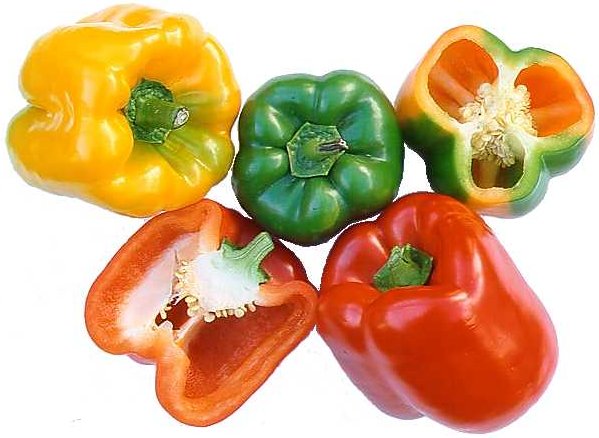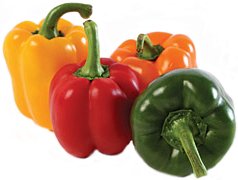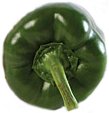

Capsicum

PEPPER; GREEN PEPPER; CHILLI PEPPER. (From Greek kapto, to bite, referring to the hot taste of the spice.) Solanaceae. Ten species of glaborus, shrubby, annual or biennial to perennial, erect to spreading herbs. Leaves alternate or paired, stipitate, in groups of 2-3 or scattered, entire, apex slender. Flowers solitary or in groups to 3, white, occasionally white tinged green, rarely violet; calyx campanulate or tubular, fleshy, enlarging slightly after flowering; corolla rotate, limb usually deeply 5-lobed, stellate; stamens 5, equal, protruding, tinged blue, anthers touching; ovary 2-3-chambered. Fruit a 2-3-chambered, shiny, pungent berry, green becoming orange, red or yellow; seeds somewhat reniform, flattened. Tropical America. Z9. CultivationGrown for their often very attractive fruits, eaten fresh or, as with the more pungent varieties, used dried and prepared as paprika, and chilli and cayenne pepper, Capsicum subspecies are commercially cultivated throughout the tropical and subtropical regions of the world, extending from their native Central and South America to the Far East, East and West Africa, which are now major producers. The sweet peppers are now available in a much extended colour range, from the commonplace green peppers which ripen to red, to include orange, yellows, purple/black and white varieties. When ripe and raw, sweet peppers are rich in vitamins A and C, their crisp texture and generally mild, sweet flavour lending them well, raw or cooked, to a wide variety of savoury dishes. The chilli peppers also occur in a range of shape, size and colour, and as a general rule, the smaller and riper the fruit, the more incendiary its flavour. The heat and pungency is much concentrated in the seed and inner surfaces of the fruit and great care must be taken during preparation to avoid contact with the eyes and other sensitive parts of the body, since the active principles are strong enough to cause blistering. Although most frequently used as crop plants, the diversity of fruit colour lends considerable ornamental value, and dwarf varieties in particular are well suited to cultivation in terracotta pots and window boxes or for sunny conservatories; those varieties grown purely as ornamentals require treatment as for Solanum psuedocapsicum. The edible peppers have requirements in cultivation similar to those for tomatoes, although they need slightly higher temperatures and humidity. Peppers in the Capsicum annum Grossum group are sometimes grown outdoors in zones with long hot summers or in warm, sheltered gardens with cloche or frame protection; outdoor plants ripen fruits about 6-8 weeks later than those grown under glass. Other varieties and species need glasshouse protection in cool temperate zones. Sow seed in late winter/early spring in the heated greenhouse: set two seeds per small pot and germinate at 21ºC, thin to the strongest seedling and grow on at 15-18ºC. Prick out as the third leaf emerges into 5-8cm pots of low-fertility loam-based potting mix, and pot on successionally into a medium-fertility mix, pH 5.5-5.8, to fruit in 10-12.5cm pots for dwarf cultivars, with a minimum pot size of 20cm for tall varieties, which will need staking. Alternatively, grow three plants in the standard sized growing bag, introducing about 10-12 weeks after sowing. Feed regularly with a dilute liquid feed to sustain growth and pinch out to encourage branching, when plants are about 15cm high. Where plants are not growing strongly, remove first flowers to promote further vegetative growth. Open-ground plants should be hardened off before setting out at 40-45cm spacings, after danger of frost is passed, into a sheltered sunny site with fertile, moisture-retentive but well-drained soil. Rake in a balanced NPK fertiliser before planting; the ground should not be freshly manured but the incorporation of well-rotted organic matter in winter, with a mulch of the same for established plants, will greatly assist the necessary moisture retention. Plant out with the initial protection of cloches, later turning cloches on to their sides to give protection from prevailing winds, before removing them completely; with large cloches, plants may be grown to maturity and ripened under cover. Ensure plentiful water to prevent checking and give tall varieties the support of canes or wires. 
Under glass, give bright filtered light throughout the summer, water plentifully and carefully and maintain high humidity with good ventilation in warm weather. The optimal temperature range for most varieties is between 21-25ºC; excessively high temperatures affect pollen viability and day temperatures above 32ºC may cause excessive transpiration leading to flower bud and fruit abscission and possibly to fruit scald. Good drainage and careful water management is also particularly important, since most varieties are sensitive to waterlogging, and water deficit will result in bud and flower abscission (with outdoor plants, excessive rainfall affects flowering and fruit set and may encourage fruit rots). Syringe flowers daily to encourage fruit set and liquid feed at 10-14 day intervals from fruit set until they begin to colour. Removal of the first green fruits when about tennis ball size will encourage further set; cropping under glass is usually from mid summer to late autumn, outdoors from late summer to first frosts. Fruits take about 2-3 weeks to ripen and colour fully, outdoor plants seldom achieve the colour change from unripe green to ripe yellows and reds, but they may be uprooted before first frosts and hung in a dry, frost-free place to aid ripening. Ripe chilli peppers will keep for several years, stored in a cool dry place, in a rope as for garlic. Red spider mite, aphid and cuspid bug, which causes distortion and destruction of leaves and growing points may be problem pests under glass. The diseases which affect Capsicum are common to many Solanaceous plants (especially tomatoes), and are more of a problem in warm climates. Virus infections can be reduced by cultural methods – weed control and use of healthy seed of resistant varieties. Anthracnose, bacterial spot, bacterial wilt, fusarium wilt and verticillium wilt can be damaging in the Southern US; their management will be aided by crop rotation, avoiding plots used for aubergine, petunias, potatoes, tomatoes and other members of the Solanaceae. Capsicum annumvariety annuum. CAPSICUM; PAPRIKA; CAYENNE PEPPER; RED PEPPER; SWEET PEPPER. Annual or short-lived perennial, to 1.5m. Stems branched, erect or creeping, fleshy or woody at base, round or angled. Leaves alternate, simple, ovate to lanceolate, to 12 x 8cm, entire. Flowers solitary, campanulate; sepals 5; petals white or green, to 15mm diameter, anthers ovate; stigma capitate. Fruit to 15cm, red, orange, yellow, to black; seeds to 4mm, pale yellow. Unknown in the wild, thought to have originated in tropical America. Most cultivated peppers belong to one of five main groups of cultivars, varying in fruit characteristics and colour. (1) Cerasiforme group (CHERRY PEPPER): fruit small, pungent, globose, tinged yellow or purple; some cultivated ornamentals. ‘Birdseye’: small, much-branching, dense; leaves narrow, thin, bright green; flowers small, white, abundant. (2) Conoides group (CONE PEPPER): fruit conic, erect, to 5cm; some cultivated ornamentals. ‘Acorn’: habit low, flattened top; leaves rich green; fruit oval, green turning purple then crimson. ‘Candle Pepper’: habit broad; leaves small, narrow; fruit erect, conical, white turning orange-red. ‘Celestial’: habit bushy, compact; leaves ovate, deep green; fruit conical, green turning purple and finally orange-red. ‘Red Chilli’: attractive; flowers white, star-shaped; fruit cardinal red, glossy, edible. (3) Fasciculatum group (RED CONE PEPPER): fruit erect, clustered, to 7.5cm, red, pungent; some cultivated ornamentals. (4) Grossum group (PIMENTO, BELL PEPPER, SWEET PEPPER); fruit campanulate, with a basal depression, thick-skinned, blunt, scarcely pungent, the principal salad peppers. (5) Longum group (CAYENNE PEPPER, CHILLI PEPPER): fruit pendent, often finely tapering to 30cm, base to 5cm diameter, very pungent. ‘Aurora’: dwarf to 10cm; fruit purple through tan to bright red. ‘Fiesta’: habit compact, bushy; fruit slender, curved, cream turning orange then red. ‘Filius Blue: dwarf to 20cm; fruit tinged blue, some turning red. ‘Holiday Cheer’: fruit small, round, cream turning bright red. ‘Holiday Time’: fruit small, conical, green turning to red or purple. ‘Piccolo’: ornamental; leaves variegated cream, pale and deep green; flowers small, lavender, star-shaped; fruit globose, black-purple. ‘Pylon Red’: dwarf; fruit red, early. ‘Red Missile’: habit compact; fruit large, conical, red. ‘Robert Craig’: densely branched; fruit short, conical, cream splashed purple turning red. ‘Treasure Red’: habit broad, neat; leaves very deep green; fruit erect, white turning red. ‘Variegated Purple’: leaves purple variegated white; fruit purple turning red. ‘Weatherillii’: leaves large, glossy; flowers white; fruit large, yellow turning red.  Capsicum baccatum
Capsicum baccatum
Spreading, glabrous to minutely pubescent herb or shrub, to 3m. Flowers solitary or paired; calyx 5-toothed, teeth to 1mm; corolla rotate, to 1.5cm diameter, white to yellow, lobed, lobes marked beige or green at base; filaments to 3mm, anthers yellow. Fruit erect, to 13 x 7mm, red; seeds cream to yellow. Tropical America. Capsicum chinenseSmall shrub, to 1.5m. Stems robust, glabrous to pubescent. Flowers pendent, to 2 or more per node; calyx base constricted, margin entire; corolla dull white, sometimes tinged green, limb spreading to recurved, anthers blue to pale purple, occasionally yellow; style, stigma slightly protruding. Fruit red-brown to cream, persistent, pendulous. Tropical America. Capsicum frutescensTABASCO PEPPER; HOT PEPPER; SPUR PEPPER. Perenial herb, to 1.5m and over. Stems woody at base. Leaves elliptic; apex acute, to 10 x 5cm. Flowers solitary or in groups of 2-3; pedicels erect, to 2.5cm; calyx tubular, 5-lobed, yellow-green; corolla pale green to yellow, limb to 1cm diameter, lobes spreading, recurved; stamens 5. Fruit in clusters, to 3 per node, to 7.5 x 1cm, green, becoming red, orange or yellow, highly pungent. Tropical America. ‘Chameleon’: plant to 30cm; fruit green through yellow, purple then red. ‘Fips’: plant to 18cm; fruit green through yellow to red. ‘Long Gold Spike’: fruit conical, yellow. ‘Paradicsomalaká Zöld’: fruit small, red, lobed, very hot. ‘Szentesi cseresnyepaprika’: small, round, green, very hot, use for pickling. ‘Westlandje’: long, thin, green to red fruits. Capsicum pubescensHerb or climbing shrub, to 3m. Stems striate, nodes dark purple; stems, leaves glabrous to pubescent. Leaves ovate, rugose, margins entire, sometimes ciliate. Flowers solitary, violet or purple, with a white eye; calyx to 6-lobed, lobes to 1mm; corolla campanulate to rotate, anthers purple to violet; stigma green. Fruit pendent to erect, cylindric to globose, yellow to red or brown. Andes, S America.
|
Home
Grow Nuts
Grow Herbs
Grow Fruit
Cyberian Index
If you like this website and want one of your own contact
Cyberian All information correct at
time of publication and open to updates as necessary. No part of this website,
or its vectors, may be produced in any shape or form, using any type or design
of medium, system, equipment or otherwise without the prior written consensual
notice of the Cyberian. Any breach of these requirements will result in the
appropriate action. If in doubt, e-mail contact is recommended.
Some components of this website were obtained as open-source software and are
used in the same non-profit manner on this website.